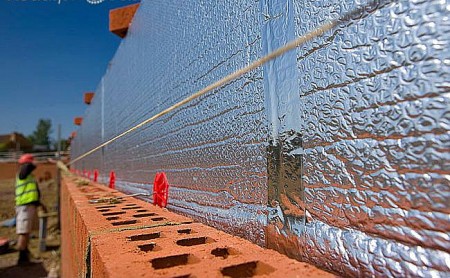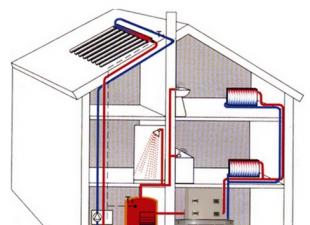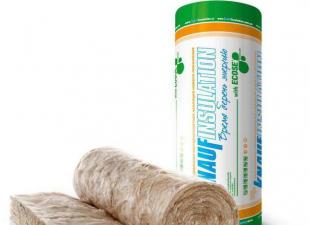If you closely follow the market of building materials, in particular, heat-insulating ones, read various reviews, you could not help but notice the appearance of a new, high-technological means of thermal protection, penofol. This material can be attributed to one of the types of reflective insulation, it consists of several layers - the base and reflective foil.
The basis of penofol, which actually gave it its name, is polyethylene foam, which has a different structure and density indicators. The foil is applied to the base by heat welding.
The foam base has a thickness of 0.2 to 1 cm, a foil thickness of 20 microns, a reflection coefficient of 97%. For use in harsh climates, manufacturers produce a special type of penofol with a main field thickness of up to 40 mm.
If in the field of construction material penofol appeared relatively recently, this does not mean that its high-tech qualities were not known. For interest, I can give a certificate stating that the first spacesuits for NASA astronauts were made using penofol.
To what can this effect be compared? With a vacuum cleaner! If you used penofol to insulate a house or apartment, do not hesitate: in winter you will always be warm and cool in summer. The fact is that penofol does not retain heat emanating from the room, but reflects it.
This modern technological material creates a barrier to direct heat transfer due to polyethylene foam, which contains a large number of pores filled with air or carbon dioxide.
The use of penofol is possible both independently and also in combination with others. It is especially convenient when you, wanting to insulate some surface, do not want to lose the size of the useful area of \u200b\u200byour room.
Penofol foil: technical characteristics of the material
- heat transfer resistance for double-sided foam foam having a thickness of 4-5 mm is 1.2-1.23 m2xC / W
– vapor permeability is about 0.001 mh/mhh Pa
Penofol foil finds application both as the main heater and as a layer of heat-insulating system.
The photo below shows an example of foil foam foam 10 mm thick.
Penofol foil
Penofol foil and its application
It can be used for:
– insulation of walls inside and outside the premises, attics and basements
– water and vapor barriers for saunas and baths
- roof insulation and
– insulation of water pipes
- heat reflection of heating batteries
– soundproofing and insulation of ventilation and sewer systems
– insulation and soundproofing of cars
- Arrangement of residential and commercial trailers
— isolation of refrigerators
Foil penofol has its advantages and disadvantages, which will have to be taken into account when choosing thermal insulation. I’ll note right away that there are much more advantages from using penofol and I’ll start with a fairly moderate price compared to other materials.
What other benefits does the consumer receive:
- high environmental friendliness
- the material is very thin compared to others
- low vapor permeability
- good sound insulation
- ease of installation
- high fire safety
- ease of transportation
- the material is difficult to reach for rodents
To the main disadvantages I'll take it:
– high deflection at the slightest pressure due to the softness of the material
- some inconvenience when strengthening: special glue compositions are needed, etc.
- if you need to insulate the walls outside your home, foil penofol is only suitable as an additional layer of thermal insulation to reflect heat energy and protect against moisture.
We check penofol for strength - watch the video:
So, we decided that we need just this type of thermal insulation.
What types of penofol are on the market and the features of their application
1. Type A- in this type of penofol, the aluminum layer is applied only from the outside.
It is used more often with foam and styrodur.
2. Type B- Coated on both sides.
Suitable for independent use.
3. Type C- self-adhesive foam.
Its outer side is covered with a layer of aluminum foil, and on the inside it is covered with polyethylene foam with contact adhesive.
4. ALP type.
A polyethylene film is glued on top of the aluminum layer. This type of penofol is called laminated. Effectively used for the needs of rural areas.
5. Type R and M- one-sided foil embossed foam.
6. Super NET, which means "network".
Used to isolate networks.
7. Penofol AIR for air outlets.
If on the counter of the store you see penofol brand Penofol-2000, be aware that this insulation is the most inexpensive type of penofol, i.e. worse in all technical characteristics and, above all, in strength.
The main methods of mounting foil foam
- the reflective layer of the material is always laid in the direction of the heat transfer source
- it is necessary to leave an air space of 10-20 mm on both sides of the insulation
– for 100% waterproofing and tightness, all joints are glued with foil tape
- most importantly: remember that foil is a very good conductor of electric current, carefully check the insulation of electrical wiring
As mentioned above, one of the remarkable qualities of penofol is ease of installation. Therefore, even without having any special knowledge, you can use it yourself when warming the house with your own hands.
As a fastener, you will need a stapler or self-tapping screws. Indoors, as a rule, penofol 4-5 mm thick is used. If you have an ordinary apartment or house, take one-sided material. If the walls are very cold, you will have to additionally insulate them with wool or.

Insulation with penofol walls from the inside
Procedure:
- roll out a foam foam roll and cut a strip from it, the length of which will be equal to the length of the wall
- using a stapler, nail it to the wall, starting from the ceiling
- if the wall is wooden, take a screwdriver, if it is concrete - put it on glue or nail it with staples
- cover the entire wall with penofol so that there are no overlaps
- glue the board with aluminum tape
- nail a frame made of river or a layer of plywood 2 cm thick onto the penofol
- place drywall or chipboard on top of the crate
In order to insulate the ceiling with penofol, cut it and attach it along the wall, starting from the middle. When you get to one corner, nail the side closest to the wall. Further from the middle, move in the opposite direction and fasten the strip further.
Then move perpendicular to the web of material to the corners, while smoothing the penofol along the ceiling all the time.
I want to remind you that penofol is a very unpretentious material to use. During its installation, you can not treat the surface with anything and even not pre-prepare it for work.
It should be noted that steam entering the building structure can lead to the appearance of mold and fungus. But when using penofol indoors, your walls will not accumulate moisture.
Choose foam types A, B, C for installation inside the house.
Now let's try them insulate the walls of the room from the outside.
By the way, many professionals claim that this method of insulation is much more effective than internal insulation, especially if you have a wooden house.
For work on warming the house from the outside, use perforated penofol, it will protect the walls from precipitation and wind, and also keep the area of \u200b\u200byour home intact without reducing it.

Wall insulation with penofol outside
Insulation is mounted between the wall and the cladding of the house. It is better to carry out work on the insulation of walls outside in the summer, because. there are no sharp fluctuations in temperature and the walls are already dry enough.
The procedure for warming the house with penofol from the outside
- remove all coatings from the walls and perform antiseptic treatment, be especially careful and meticulous when processing corners and the bottom of the walls, because. it is these areas that are prone to freezing and putrefactive processes
- build a frame from the bars and attach it with self-tapping screws
- lay penofol, not forgetting to leave a gap for air
- Seal all seams with foil tape
- mount the outer frame and begin to clad the room
So, today we have studied in sufficient detail the properties of penofol, one of the most popular modern heat insulators. If you want to protect your home not only from cold and moisture, but also from noise, if you are interested in keeping the maximum usable area of the room and still be in financial gain, give your preference to this magnificent material.
We compare penofol with other analogues, watch the video
 budivel.ru About the insulation and heating of the house.
budivel.ru About the insulation and heating of the house.


